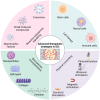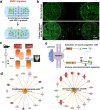Spinal cord injury: molecular mechanisms and therapeutic interventions
- PMID: 37357239
- PMCID: PMC10291001
- DOI: 10.1038/s41392-023-01477-6
Spinal cord injury: molecular mechanisms and therapeutic interventions
Abstract
Spinal cord injury (SCI) remains a severe condition with an extremely high disability rate. The challenges of SCI repair include its complex pathological mechanisms and the difficulties of neural regeneration in the central nervous system. In the past few decades, researchers have attempted to completely elucidate the pathological mechanism of SCI and identify effective strategies to promote axon regeneration and neural circuit remodeling, but the results have not been ideal. Recently, new pathological mechanisms of SCI, especially the interactions between immune and neural cell responses, have been revealed by single-cell sequencing and spatial transcriptome analysis. With the development of bioactive materials and stem cells, more attention has been focused on forming intermediate neural networks to promote neural regeneration and neural circuit reconstruction than on promoting axonal regeneration in the corticospinal tract. Furthermore, technologies to control physical parameters such as electricity, magnetism and ultrasound have been constantly innovated and applied in neural cell fate regulation. Among these advanced novel strategies and technologies, stem cell therapy, biomaterial transplantation, and electromagnetic stimulation have entered into the stage of clinical trials, and some of them have already been applied in clinical treatment. In this review, we outline the overall epidemiology and pathophysiology of SCI, expound on the latest research progress related to neural regeneration and circuit reconstruction in detail, and propose future directions for SCI repair and clinical applications.
© 2023. The Author(s).
Conflict of interest statement
The authors declare no competing interests.
Figures




References
Publication types
MeSH terms
LinkOut - more resources
Full Text Sources
Medical
Miscellaneous

